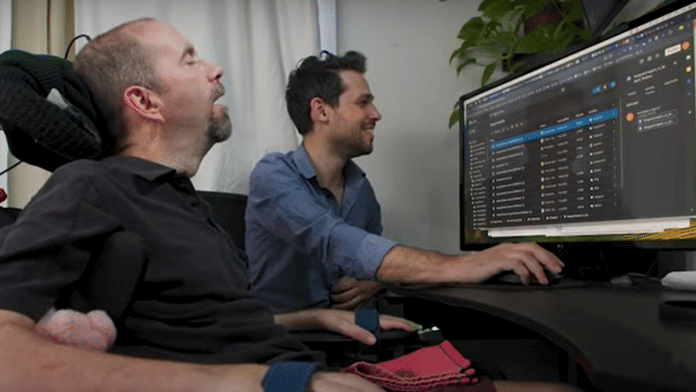New Delhi: A study by University of California, Davis used a brain-computer interface (BCI) tool to help translate the brain’s signals of a man suffering from ALS into computer-generated speech — with 97 percent accuracy. Published on 14 August in the New England Journal of Medicine, the study was conducted on 45-year-old Casey Harrell who has been suffering from amyotrophic lateral sclerosis (ALS) for the past five years. ALS is a disease that inhibits nerve cells and affects movement and speech.
Scientists from UC Davis surgically implanted the BCI in the patient’s brain, and saw that on the first day of its use, the device showed 99 percent accuracy in translating his thoughts to speech. Made up of four microelectrode arrays, the BCI was implanted in the location of the brain that receives and coordinates the nerve signals for speech. It was connected to a computer that translated these signals to text, and then a voice programmed to sound like the patient’s based on previous recordings, read these aloud. The BCI relies on machine learning techniques and large amounts of data, including 248 hours of use by the patient Harrell alone. This study records a new breakthrough in communication research for ALS patients. Read more here.
Researchers revisit 400 years of literature for most thorough study yet on extinct Dodo bird
To clear misconceptions and correctly identify and place the Dodo bird in zoological history, researchers from the University of Southampton are revisiting literature about the bird from 400 years ago. In a study published on 16 August in the Zoological Journal of the Linnean Society, researchers explain how certain historical texts claimed the Dodo was ‘mythological’, or unsuited to its natural environment which is why it became extinct. However, their work shows that it was a rather strong and fast ground animal, with tendons that are “analogous to climbing and running birds”.
The study aimed to analyse literature on both the Dodo and the Rodrigues solitaire birds, both flightless ground birds native to an island, and both extinct.
The researchers found they both belonged to the Columbidae family — the same as pigeons and doves. They were both thus classified as large ground doves, taxonomically, and the study sheds a key insight into how there are no longer any species of large ground doves alive today. The birds were adapted to their environment, but went extinct “within a century of their first encounter with humanity”, the study said.
The study aims to add to historical knowledge and create the first comprehensive overview of the nomenclature surrounding the extinct bird. Read more here.
The asteroid that probably killed dinosaurs originated near Jupiter, find scientists
A study published in Science Journal on 15 August sought to track down the asteroid that struck the earth around 66 million years ago, leading to a mass extinction event that possibly wiped out the dinosaurs. Scientists from the University of Cologne found that the asteroid in question was a ‘carbonaceous-type’ one, based on rock samples and isotope composition studies conducted on it. The study revealed that the asteroid possibly came from the outer Solar System, and further analysis of its structure showed that it was similar in composition to asteroids found outside Jupiter’s orbit.
The mass extinction event 66 million years ago, between the Cretaceous era and the Paleogene era, led to almost 70 percent of the earth’s animals becoming extinct. The most common theory around this extinction event is that an asteroid hit the earth in the Chicxulub region in Mexico, after which large dust particles rose up and deposited around the globe. The scientists analysed these sediments from three different locations to assess the origin of the impactful asteroid. Read more here.
Vikings were flexible with fines, shows new interpretation of 9th century Swedish inscription
A new interpretation of the runic inscription on the Swedish Forsa Ring provides new understanding of Viking Age monetary practices. Research from Stockholm University published on 14 August suggests that Vikings could pay fines either with oxen or silver, not both, as previously believed. The researchers re-evaluated what is the oldest Viking record of economic value — an iron ring from the Swedish region of Hälsingland, dated to the 9th or 10th century.
The study indicates that the word “auk” on the inscription should be understood as “also” rather than “and”. This re-translation changes the understanding of the fines, showing that either an ox or two ore of silver could be used. This flexibility in payment methods highlights a more practical and efficient system than previously thought, aligning with later Scandinavian legal practices and offering new insights into early European economic history. Read more here.
Also read: Llama nanobodies can target HIV-1 strains & Sun starts next solar cycle halfway throught current one







I am a CALS of my 68 year old Husband who suffered from muscle tiredness brought on by chronic fatigue in its early stages. Neurologists first had difficulty diagnosing it until multiple examinations indicated ALS, for which there was no known cure other than the prescription of riluzole medications, vitamins, and therapies. More advancements in breathing difficulties, difficulty pronouncing words, and difficulties eating occurred before we made the decision to try different medications, which significantly enhanced his condition. He received treatment for ALS/MND at vinehealthcentre. com from the U.S approximately four months ago; since then, he has stopped using a feeding tube, sleeps well, works out frequently, and has become very active. Although it doesn’t cure his ALS, it has improved his quality of life. .